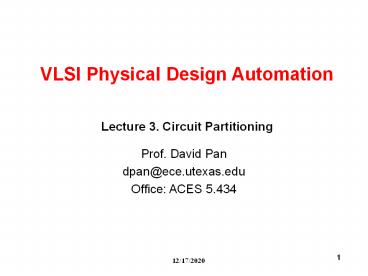VLSI Physical Design Automation - PowerPoint PPT Presentation
Title:
VLSI Physical Design Automation
Description:
Covering / Technology Mapping: Clustering such that each partitions ... D Nets: {A,B,C}, {B,D}, {C,D} Hypergraph: Vertices: A, B, C, D Hyperedges: {A,B,C}, {B ... – PowerPoint PPT presentation
Number of Views:470
Avg rating:3.0/5.0
Title: VLSI Physical Design Automation
1
VLSI Physical Design Automation
Lecture 3. Circuit Partitioning
- Prof. David Pan
- dpan_at_ece.utexas.edu
- Office ACES 5.434
2
System Hierarchy
3
Levels of Partitioning
System
System Level Partitioning
PCBs
Board Level Partitioning
Chips
Chip Level Partitioning
Subcircuits / Blocks
4
Partitioning of a Circuit
5
Importance of Circuit Partitioning
- Divide-and-conquer methodology
- The most effective way to solve problems of high
complexity - E.g. min-cut based placement, partitioning-based
test generation, - System-level partitioning for multi-chip designs
- inter-chip interconnection delay dominates
system performance. - Circuit emulation/parallel simulation
- partition large circuit into multiple FPGAs
(e.g. Quickturn), or multiple special-purpose
processors (e.g. Zycad). - Parallel CAD development
- Task decomposition and load balancing
- In deep-submicron designs, partitioning defines
local and global interconnect, and has
significant impact on circuit performance
6
Some Terminology
- Partitioning Dividing bigger circuits into a
small number of partitions (top down) - Clustering cluster small cells into bigger
clusters (bottom up). - Covering / Technology Mapping Clustering such
that each partitions (clusters) have some special
structure (e.g., can be implemented by a cell in
a cell library). - k-way Partitioning Dividing into k partitions.
- Bipartitioning 2-way partitioning.
- Bisectioning Bipartitioning such that the two
partitions have the same size.
7
Circuit Representation
- Netlist
- Gates A, B, C, D
- Nets A,B,C, B,D, C,D
- Hypergraph
- Vertices A, B, C, D
- Hyperedges A,B,C, B,D, C,D
- Vertex label Gate size/area
- Hyperedge label
- Importance of net (weight)
B
A
C
D
B
A
C
D
8
Circuit Partitioning Formulation
9
A Bi-Partitioning Example
a
c
e
100
100
100
100
100
9
4
b
d
f
100
10
Min-cut size13 Min-Bisection size
300 Min-ratio-cut size 19
Ratio-cut helps to identify natural clusters
10
Circuit Partitioning Formulation (Contd)
11
Partitioning Algorithms
- Iterative partitioning algorithms
- Spectral based partitioning algorithms
- Net partitioning vs. module partitioning
- Multi-way partitioning
- Multi-level partitioning
- Further study in partitioning techniques
(timing-driven )
12
Iterative Partitioning Algorithms
- Greedy iterative improvement method
- Kernighan-Lin 1970
- Fiduccia-Mattheyses 1982
- krishnamurthy 1984
- Simulated Annealing
- Kirkpartrick-Gelatt-Vecchi 1983
- Greene-Supowit 1984
13
Kernighan-Lin Algorithm
An Efficient Heuristic Procedure for
Partitioning Graphs The Bell System Technical
Journal 49(2)291-307, 1970
14
Restricted Partition Problem
- Restrictions
- For Bisectioning of circuit.
- Assume all gates are of the same size.
- Works only for 2-terminal nets.
- If all nets are 2-terminal,
- the Hypergraph is called a Graph.
B
B
A
A
Hypergraph Representation
Graph Representation
C
D
C
D
15
Problem Formulation
- Input A graph with
- Set vertices V. (V 2n)
- Set of edges E. (E m)
- Cost cAB for each edge A, B in E.
- Output 2 partitions X Y such that
- Total cost of edges cut is minimized.
- Each partition has n vertices.
- This problem is NP-Complete!!!!!
16
A Trivial Approach
- Try all possible bisections. Find the best one.
- If there are 2n vertices,
- of possibilities (2n)! / n!2 nO(n)
- For 4 vertices (A,B,C,D), 3 possibilities.
- 1. XA,B YC,D
- 2. XA,C YB,D
- 3. XA,D YB,C
- For 100 vertices, 5x1028 possibilities.
- Need 1.59x1013 years if one can try 100M
possbilities per second.
17
Idea of KL Algorithm
- DA Decrease in cut value if moving A
- External cost (connection) EA Internal cost IA
- Moving node a from block A to block B would
increase the value of the cutset by EA and
decrease it by IA
X
Y
X
Y
B
B
C
C
A
A
D
D
DA 2-1 1 DB 1-1 0
18
Idea of KL Algorithm
- Note that we want to balance two partitions
- If switch A B, gain(A,B) DADB-2cAB
- cAB edge cost for AB
X
Y
X
Y
B
B
C
C
D
A
A
D
gain(A,B) 10-2 -1
19
Idea of KL Algorithm
- Start with any initial legal partitions X and Y.
- A pass (exchanging each vertex exactly once) is
described below - 1. For i 1 to n do
- From the unlocked (unexchanged) vertices,
- choose a pair (A,B) s.t. gain(A,B) is
largest. - Exchange A and B. Lock A and B.
- Let gi gain(A,B).
- 2. Find the k s.t. Gg1...gk is maximized.
- 3. Switch the first k pairs.
- Repeat the pass until there is no improvement
(G0).
20
Example
X
Y
1
4
2
5
3
6
Original Cut Value 9
A good step-by-step example in SY book
21
Time Complexity of KL
- For each pass,
- O(n2) time to find the best pair to exchange.
- n pairs exchanged.
- Total time is O(n3) per pass.
- Better implementation can get O(n2log n) time per
pass. - Number of passes is usually small.
22
Recap of Kernighan-Lins Algorithm
- Pair-wise exchange of nodes to reduce cut size
- Allow cut size to increase temporarily within a
pass - Compute the gain of a swap
- Repeat
- Perform a feasible swap of max gain
- Mark swapped nodes locked
- Update swap gains
- Until no feasible swap
- Find max prefix partial sum in gain sequence g1,
g2, , gm - Make corresponding swaps permanent.
- Start another pass if current pass reduces the
cut size - (usually converge after a few passes)
u ?
v ?
locked
23
A Useful Survey Paper
- Charles Alpert and Andrew Kahng, Recent
Directions in Netlist Partitioning A Survey,
Integration the VLSI Journal, 19(1-2), 1995, pp.
1-81. - Next lecture more on partitioning































